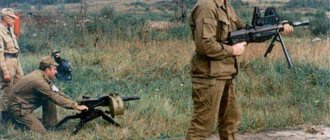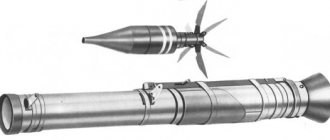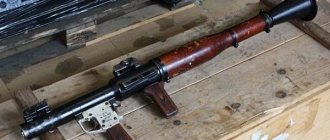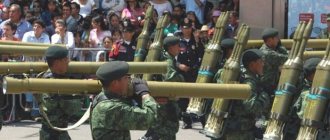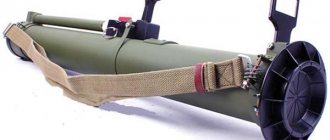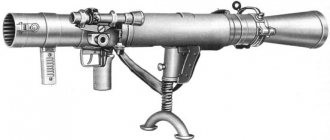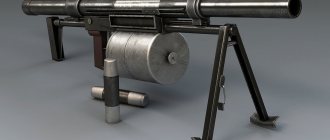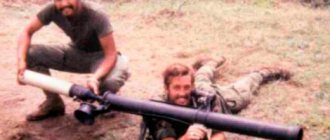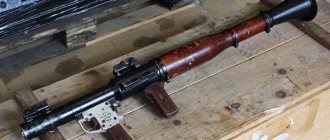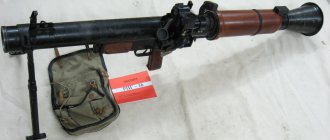A person can throw a grenade up to a maximum of 50 meters. However, many circumstances during combat operations force the use of a grenade at distances of up to 100-200 meters. But what if a person cannot throw a grenade at such a distance? It was this problem that Valery Nikolaevich Teleshev took up at the end of 1970. Thanks to its development, the military leadership received an effective weapon, compact in size, capable of replacing a hand grenade.
Grenade launcher complex "Penal"
The birth of the "seven"
Its development began in 1944 at the GAU Small Arms and Mortar Weapons Research Site.
These works were supervised by the leading designer of the test site, Georgy Lominsky, who later became one of those who created the Soviet nuclear shield. Lominsky managed to construct a fairly simple complex, consisting of a grenade launcher itself, reusable, like a bazooka, and a cumulative grenade, which was fired in the same way as a Faustpatron grenade. What is noteworthy is that already in the first Soviet RPG the characteristic features of the future RPG-7 are discernible: loading from the muzzle, a pistol control handle located in the first third and a wooden barrel. Its creators managed to complete all the main work on the new weapon in just a year, but the modification of the ammunition dragged on for another three years, and as a result, the RPG-1 was never put into service. Instead, the first Soviet serial anti-tank hand grenade launcher was the RPG-2, which was put into service in 1947. He could have even managed to become a participant in the first major local conflict after the end of World War II - the Korean War, but he did not get there because he suffered from many “childhood diseases.” In particular, the powder charge that fired the grenade from the barrel of the RPG-2 consisted of black powder, and the cloud of smoke immediately unmasked the shooter. Secondly, the ejector charge itself was rather weak, which ensured the low flight speed of the RPG-2 projectile. In fact, this resulted in a sharp decrease in the accuracy of the hit: the wind, especially the side wind, knocked the projectile off its trajectory so much that the effective impact range did not exceed 100 meters. Another unpleasant feature of the “two” also emerged. This grenade launcher had a paper cartridge of a powder charge: it was too fragile to keep the weapon constantly loaded, and outside the barrel it easily became wet, making loading impossible.
But all these shortcomings were not very important against the background of the main drawback of the RPG-2 - narrow specialization. It could only be used as a weapon to fight tanks, while by the mid-1950s it became clear that the army needed a universal portable weapon, suitable for fighting enemy personnel, including shooting at their shelters. This put forward new requirements for hand-held anti-tank grenade launchers: they had to have a longer firing range, greater charge power, increased accuracy and become more survivable and reliable.
In 1956, the Soviet leadership assigned the Moscow GSKB-47, which specialized in the development of ammunition, to solve these problems, since it was the characteristics of the shot that primarily determined the capabilities of the new grenade launcher system. The grenade launcher itself was designed in Kovrov at OKB-575 at the local weapons plant named after Vasily Degtyarev, his son Vladimir Degtyarev became the chief designer, and several other design bureaus and enterprises were involved in sights, fuses and other elements. Through their joint efforts, by the summer of 1959, they managed to create the weapons required by the Soviet army, which was confirmed by the results of the demonstration of the RPG-7 complex to the then USSR Minister of Defense, Marshal Rodion Malinovsky. It took another year to eliminate the shortcomings of the new weapon noted by the minister and his advisers, and the same amount for field testing with final refinement. And finally, on June 15, 1961, the new Soviet hand-held anti-tank grenade launcher was adopted by the Soviet Army by Decree of the Council of Ministers of the USSR No. 535-222. And soon the allies and satellites of the Soviet Union began to receive it, starting with the armies of the Warsaw Pact countries and ending with the people's liberation movements of Asia and Africa.
History of the grenade launcher
A grenade launcher is a portable firearm designed to destroy enemy equipment, structures or manpower by firing ammunition that is significantly larger in caliber than a small arms cartridge. Over the history of its development, the grenade launcher has undergone significant changes; many different types have appeared, used in different ways in certain combat situations. However, the main purpose of this formidable weapon has remained virtually unchanged.
One of the ancestors of the grenade launcher is the hand-held mortar, created in the 15th-16th centuries. Its inventor chose to remain incognito. He managed to create a virtually revolutionary thing by changing only one detail - the core that loaded the squeak on a grenade loaded with black powder. Actually, the question arises: what did this device look like? Most often, the mortar was bronze, the chamber was 5-6.25 cm in diameter and 10-30 cm in length. It was mounted on a stock, which was made of bog oak or walnut in the form of a butt, and had a gun lock mounted on the stock . From an aesthetic point of view, the weapon certainly attracted attention. If we look at it from a functional point of view, everything depended on the troops. The infantry had a regular rifle butt, while the cavalry had a longer butt and a square cutout at its end. They were used from the 17th century until the beginning of the 19th century. Subsequently, the flintlock was replaced with a capsule lock. However, this type of weapon was not widely used, since the grenade was loaded with a small charge of black powder, so its fragmentation effect had a low damaging effect. And the shooting process itself was hampered by strong recoil, so when shooting it was necessary to rest the back of the barrel against the ground or the deck of the ship.
The second prototype is a gun. Its creator is London lawyer Jameson Puckle. Mr. Pakl patented his invention in 1718. His “gun” was equipped with a quick-change drum, which housed 11 ready-to-fire charges. The caliber was large enough to replace the large bullets proposed by Pakl with small grenades. Contemporaries did not appreciate the invention: it was too complex for the 18th century.
The second wind of the hand-held mortar opened at the beginning of the 20th century, but with some changes. The first muzzle grenade launchers were created, which looked like this: a shortened rifle with a primitive launcher attached to it. But the most popular at that time were homemade products created, as they say, on the spot, in the trenches of the First World War. The soldiers used a hand grenade, soldered an old ramrod to the bottom, and then inserted the resulting structure into the barrel of the rifle. The shot was fired with a blank cartridge. Over time, the production of this kind of weapon was put “on rails”, since homemade products disfigured rifle barrels, so it would be more convenient to use special overhead devices.
During World War II, another type of weapon became widespread - tanks. Initially, the infantry did not have any effective means of defeating armored vehicles. If there were guns, then they were a temporary measure, which was caused by extreme necessity. This situation was corrected by the appearance of anti-tank grenade launchers. The first examples were the American Bazooka or the German Panzerfaust, which were able to significantly increase the vulnerability of armored vehicles.
After the war, anti-tank grenade launchers were actively improved. In this vein, the Soviet RPG-7, which is still used today, should be noted. In terms of distribution in different countries, it is comparable only to the Kalashnikov assault rifle.
The United States had a very ambitious program to create new types of infantry weapons and ammunition. It is known by the abbreviation SPIW (special purpose individual weapon). The NIBLICK project was part of it. As a result, a fragmentation grenade with a caliber of 40 millimeters was developed.
This ammunition gave impetus to the creation of several types of weapons:
• Light infantry grenade launcher. Both single-shot and multi-shot models are available.
• Underbarrel grenade launcher. Attaches to an assault rifle and significantly expands its capabilities.
• Automatic easel grenade launcher. A powerful infantry support weapon. Capable of firing in bursts.
Later, at the turn of the 60-70s of the last century, similar systems appeared in the USSR.
Recently, the development of grenade launchers has taken two paths:
• Increasing and expanding the capabilities of anti-tank models.
• Improvement of small caliber fragmentation grenades. For example, in the American advanced complex it was possible to increase the flight range of such ammunition to 2000 meters.
The list of tasks that are successfully solved using various grenade launchers speaks for itself:
• Destruction of all types of moving small targets (tanks, armored vehicles, infantry fighting vehicles, trucks, river and sea boats, etc.);
• Suppression and destruction of fortified firing points (bunkers, armored caps, pillboxes and simply machine gun nests);
• Defeat enemy fire weapons and manpower located both in open areas and in trenches, as well as on reverse slopes and in ravines;
• Combating low-flying enemy aircraft, primarily fire support helicopters
Types of grenade launchers
Modern grenade launchers in the world are classified according to several main characteristics, some of which characterize the purpose of the weapon, while others characterize its design features. Sometimes the same model belongs to several types of grenade launchers. For example, the Soviet LNG-9 “Spear”, which is simultaneously reusable, anti-tank, mounted and jet. Nevertheless, in general, the classification is quite obvious and usually does not raise questions. We will give examples of some grenade launchers that seemed very interesting to us, but, of course, our list will be limited, since in reality today the quantity and quality of this type of weapon is much wider.
Muzzle launchers
One of the first copies of such a grenade launcher was created by Staff Captain Dyakonov in 1916. The rifle grenade launcher was a steel pipe to which a cup-shaped part was screwed, connected by a narrow part to a neck that was placed directly on the rifle barrel instead of a bayonet. The Dyakonov grenade launcher was rifled, however, there were also smooth-bore devices.
In the 60s, interest in muzzle systems noticeably faded due to the fact that under-barrel grenade launchers became more popular. However, for example, in the Israeli army in the “zero” VT43 and IMI were actively used. They were fired from a Galil automatic rifle, which has now been removed from service.
Under-barrel and manual
M203 underbarrel grenade launchers entered service for the first time in the US Army. They appeared in the USSR only in 1978; the grenade launchers were identified as GP-25 Koster. Later, the army was equipped with the GP-30 Obuvka, and at the beginning of the 2000s - with the GP-34. All these grenade launchers use VOG-25 rounds of various modifications. Today, modern assault rifles are often additionally equipped with under-barrel grenade launchers. Fire from this type of weapon is carried out with special ammunition containing a warhead and a propellant charge.
The main advantage of under-barrel systems is ease of use. The soldier does not need to store special blank cartridges; he can open fire at any time from either a grenade launcher or an assault rifle.
An under-barrel grenade launcher is used to destroy enemy personnel and unarmored vehicles. It uses special ammunition that combines both a grenade and a propellant charge in one housing. The grenade launcher is mounted under the barrel of the machine gun. The trigger and sighting devices are designed for firing with the left hand, because the right hand holds the machine gun by the main fire control handle.
An example of this type of grenade launcher is the RG-6 “Gnome”. The entire structure is assembled on a body in the shape of a disc-shaped box with a tubular axis and a tubular rod. The axle is fitted with a helical winding spring that produces torsion. The barrel block includes six 40-mm “mortars”, united at the front by a bushing and at the rear by a plan washer with a ratcheting device. The bore of the “mortar” is similar to the GP-25 barrel and has 12 screw rifling. Unlike the GP-25, the barrel has a non-separable bottom with two holes: the firing pin is freely inserted into the central one, and the ejector rod is inserted into the side one.
Another example is the RG “Penal” - a hand-held disposable grenade launcher. It was developed in the late 1970s by Valery Nikolaevich Telesh. The Penal disposable hand grenade launcher is intended to replace a hand grenade under certain circumstances. Outwardly, the “Pencil” actually resembles a schoolboy’s equipment, but it allows you to throw the VOG-25 at 100-300 m.
Rocket launchers
The recoilless rifle was created in the USA in 1910. It was quite simple to use: the closed breech of the barrel was opened in such a way that part of the powder gases protruded back when fired, thereby compensating for recoil. Thanks to this, the mass of the artillery system was reduced and its use was simplified.
Modern rocket-propelled grenade launchers also have this type of device, but they differ in that the fired projectile is equipped with its own engine. For example, RPG-18 "Fly". It must be said that the rocket models were originally created as a universal artillery system, but modern grenade launchers are designed to combat enemy armored vehicles.
For example, the MRO-A "Borodach" was developed on the basis of the RShG-2 rocket-propelled assault grenade and is intended for arming flamethrower units of the chemical forces as a lighter and less powerful alternative to the RPO-A "Shmel" flamethrower, while the RShG-2 is according to the domestic classification "grenade".
The main external difference between the MPO-A and the RShG-2 is the sighting devices: on the RShG-2 they are similar to the sight on the RPG-26 anti-tank grenade, while on the MPO-A the sighting devices are similar to those on the RPO-A Shmel rocket-propelled flamethrower. In addition to the basic version MRO-A with a thermobaric warhead, variants MRO-Z with an incendiary warhead and MRO-D with a smoke warhead for instant installation of a smoke curtain are also produced and put into service.
Anti-tank grenade launchers
On the eve of World War II, the world's first cumulative projectiles suitable for combat use were created. They had an important advantage over other types of anti-tank systems: armor penetration was strong, despite the possibility that the projectile would miss the target.
The first anti-tank grenade launcher was the M1 Bazooka. Afterwards, German “faustpatrons” were created, however, the RPG-7 grenade launcher is one of the most powerful systems of our time, and the RPG-28 is the most powerful grenade launcher to date.
One example of an anti-tank grenade launcher is the RPG-29 “Vampire” (TKB-0175, GRAU index - 6G20) - a Soviet hand-held anti-tank grenade launcher. This is a modern weapon for a motorized rifle squad to destroy all types of modern tanks, armored and unarmored vehicles, as well as manpower in various types of defensive structures.
Reusable grenade launchers
While some grenade launchers, for example, the RPG-18 “Mukha,” require the launch tube to be thrown away after firing, the RPG-32 “Barkas” and RPG-7 are reusable systems. They can be recharged and reused.
The RPG-7 grenade launcher is a reusable hand-held anti-tank grenade launcher (also a rocket-propelled anti-tank grenade) for firing cumulative ammunition. It was put into service in 1961. It is designed to combat tanks, self-propelled artillery units and other enemy armored vehicles, and can be used to destroy enemy personnel in shelters, as well as to combat low-flying air targets.
This grenade launcher replaced the RKG-3 hand grenade, the VG-45 rifle grenade launcher, and the RPG-2 anti-tank grenade launcher.
Interesting fact: there are about 150 known cases of the destruction of airplanes and helicopters from the RPG-7, which is why the grenade launcher can compete in effectiveness with MANPADS.
Easel grenade launchers
They are adapted to fire in bursts. The ammunition used in these systems is similar in appearance to VOG rounds, however, they have different dimensions. The first OAZ was developed in the USSR by Taubin in the late 30s. In the USA in 1968, during the Vietnam War, the MK 19 weapon was created. And already in 1971, the USSR invented the AGS-17 “Flame”, which was not inferior in characteristics to the American one. After the easel grenade launcher, they were able to make it twice as light - AGS-30. In 2010, modified and designated AGS-40. LNG-9 “Spear” is also popular.
It must be said that grenade launchers are an integral part of combat. Thanks to this type of weapon, the anti-tank defense of troops was strengthened, flexible fire support was provided, and their diversity allows them to be a universal means of combat.
Grenade launcher from grenade launchers
Actually, it was from this time that the triumphant march of the RPG-7 around the world began. The simple, reliable and powerful weapon was quickly appreciated, as was its high versatility. It was most clearly demonstrated by soldiers of the North Vietnamese army and fighters of the National Liberation Front of South Vietnam, who managed to shoot down 128 American helicopters with a grenade launcher during the fighting. Subsequently, such a use, which was not initially even envisaged, became common: RPG-7s were used against helicopters in Angola, Afghanistan, Chechnya, and in many other local conflicts.
The use of the “seven” against armored vehicles was extremely effective. American tankers in Vietnam were the first to realize this from their sad experience: M-48 tanks turned out to be as defenseless against Soviet RPGs as the Korean T-34-85 were against bazookas during the Korean War. What can we say about lighter armored vehicles like armored personnel carriers and infantry fighting vehicles of all types! Alas, this fully applies to Soviet technology: both in Afghanistan and Chechnya, militants very effectively destroyed Soviet and Russian armored personnel carriers and infantry fighting vehicles with shots from Soviet grenade launchers.
It is also noteworthy that the abbreviation RPG, or, in the English version, RPG, has entered military dictionaries around the world. At the same time, the English-language name is a backronym: in the West, the spelling of the Russian name in Latin is now deciphered as “rocket-propelled grenade,” that is, a dynamo-propelled grenade. And this, perhaps, is one of the most striking examples of recognition of the unique place that the RPG-7 grenade launcher created in our country has occupied for more than half a century in the world history of weapons.
Why the Tula “Penal” was not in demand
At the end of the seventies, as an experiment, a disposable grenade launcher “Penal” was created, which was distinguished by its small size and fairly high combat characteristics. The designer of the Tula TsKIB SOO Valery Nikolaevich Telesh began developing an original grenade launcher that combines convenience and high combat qualities. The product, with the working title “Pencil Case,” was based on a number of interesting ideas and was distinguished by its simplest design. The grenade launcher was planned to be disposable and always ready for use. He should have used a VOG-25 shot or other 40 mm ammunition, including non-lethal ammunition.
The resulting sample could be of interest for different structures. First of all, the customer could be an army interested in developing an infantry weapons system. The non-lethal “Penal” could be of interest to various structures from the Ministry of Internal Affairs or the KGB.
The Penal disposable grenade launcher was externally a metal cylinder with closed ends. On the side there was a simple trigger mechanism with a safety pin and ring. The length of the product was 200 mm, the diameter was approx. 45 mm, weight with ammunition - 700 g.
It was proposed to use different ammunition as part of the Penal system. First of all, this is the VOG-25 fragmentation grenade and its modifications. It was also possible to use a standardized “Nail” product with a CS type irritant, a VDG-40 smoke grenade, etc.
The estimated muzzle velocity of the grenade reached 90 m/s. The maximum firing range is 300 m. Low accuracy was expected, but it had to be compensated by the action of the ammunition: the scattering of fragments of a combat grenade or the formation of a gas cloud from a non-lethal product.
By maximizing the simplification of the design, it was possible to reduce the cost of mass production. The serial “Penal” turned out to be not much more expensive than the VOG-25 fragmentation grenade. Consequently, for the price of two grenades one could get not only ammunition, but also a device for throwing it over a long range.
The grenade launcher could be carried in any suitable pouch or otherwise.
It is known, writes Military Review, that TsKIB SOO produced at least one experimental grenade launcher that was used in testing. The calculated parameters and combat qualities were confirmed. However, this fact did not affect the real prospects of the grenade launcher. According to known data, none of the departments considered as potential customers wanted to purchase “Pencil Cases”. There was simply no room for such products in the existing weapons systems of the Ministry of Defense, the Ministry of Internal Affairs and the KGB. The military and security forces continued to use standard hand grenades and grenade launchers of all existing models.
According to some sources, the “Penal” was nevertheless adopted by one of the security forces and was even produced in small series. However, such information is not confirmed by anything - and contradicts reliably known information from other sources.
The reasons for the failure of the Penal project are obvious. First of all, the prospects for this development were negatively affected by its proactive nature. None of the departments ordered the development of such weapons - because they did not need them. According to the test results, there was no interest in this product.
Thus, the main result of the Pencil project should be considered a test of the viability of the original idea. The grenade launcher did not reach series production and did not enter service, but it left an interesting mark on the history of domestic grenade launchers.
- Tula
- TsKIB
- grenade launcher
- army
Tell everyone about it!
Subscribe to our channel on Yandex.News
Penalty grenade launcher
The 40-mm hand-held disposable grenade launcher “Penal” was developed in the late 1970s by Valery Nikolaevich Telesh. The “Penal” hand-held disposable grenade launcher is intended, under certain circumstances, to replace a hand grenade (which, as is known, can be thrown at most 30-40 m). Outwardly, the “Pencil” actually resembles a schoolboy’s equipment, but it allows you to throw the VOG-25 at 100-300 m.
The Penal grenade launcher is a rifled thin-walled aluminum barrel without a sight, in the middle part of which there is a breech with a simple impact mechanism. A VOG-25 (VOG-25 P) shot or a shot with a bird cherry is inserted in front; at the back there is a countermass - aluminum or plastic plates that are thrown out, reducing recoil.
The Penal striker is cocked in advance and stands on a safety pin - again, like a hand grenade. The ends of the barrel are closed with easily destructible sealed caps.
Before firing, you just need to remove the safety pin, move your hand with the “Pencil Case” to the side so as not to catch yourself and your neighbors with the flying countermass, aim it at the target, set the elevation angle according to the remote scale and press the trigger lever. No special precision is required, the main thing is the damaging effect of the fragments.
The cost of manufacturing a grenade launcher is not much higher than the cost of manufacturing a shot for an under-barrel grenade launcher, but this grenade launcher allows you to hit targets at a range of up to 300 m.
The “pencil case” can be used to shoot not only combat grenades, but also grenades filled with the irritating toxic substance CS or rubber bullets.
Disposable grenade launcher "Pencil". A hopeless initiative
Product "Pencil" and its ammunition. Photo Weaponland.ru
The throwing range of a hand grenade is determined by the physical condition and skills of the fighter, but does not exceed several tens of meters. To attack more distant targets, it is necessary to use technical means - a variety of grenade launchers. At the end of the seventies, as an experiment, a disposable grenade launcher “Penal” was created, which was distinguished by its small size and fairly high combat characteristics.
Problem and solution
A hand grenade is small in size and weight, but its flight range does not exceed 30-40 m. Grenade launchers can be fired at hundreds of meters, but have significant dimensions and weight.
In a number of situations, a fighter may need a lightweight and compact system suitable for throwing a grenade over long distances. At one time, under-barrel grenade launchers became a good solution to this problem, but they could only be used with machine guns, which could lead to ergonomic and operational difficulties. At the end of the seventies, the designer of the Tula TsKIB SOO Valery Nikolaevich Telesh began developing an original grenade launcher that combined convenience and high combat qualities. The product, with the working title “Pencil Case,” was based on a number of interesting ideas and was distinguished by its simplest design. The grenade launcher was planned to be disposable and always ready for use. He should have used a VOG-25 shot or other 40-mm ammunition, incl. non-lethal equipment.
The resulting sample could be of interest for different structures. First of all, the customer could be an army interested in developing an infantry weapons system. The non-lethal “Penal” could be of interest to various structures from the Ministry of Internal Affairs or the KGB.
A course towards simplification
The Penal disposable grenade launcher was externally a metal cylinder with closed ends.
On the side there was a simple trigger mechanism with a safety pin and ring. The length of the product was 200 mm, the diameter was approx. 45 mm, weight with ammunition - 700 g. The main part of the grenade launcher was a rifled barrel. It was made in the form of a thin-walled aluminum tube with the necessary holes and internal elements. In the front part of the tube, rifling was provided, similar to the rifling of the GP-25 grenade launcher. To fix the shot in the working position, there were stops inside the barrel.
The trigger mechanism was placed on the side of the barrel. It consisted of a spring plate with a striker, its support and a fuse in the form of a pin. When fired, the spring was supposed to provide an impact on the grenade primer.
Reconstruction of the appearance of the “Pencil Case”. In the foreground is a combat-ready grenade launcher, behind is a VOG-25 shot, barrel and countermass blocks. Graphics War-time.ru
No devices were provided to improve the ergonomics of the weapon. It was proposed to take and hold the grenade launcher by the body-barrel. Horizontal guidance was carried out “by eye”. Experienced grenade launchers did not have means for vertical aiming, but, according to some information, in the future it was planned to apply a simple rangefinder scale to the body.
The Pencil product had to be assembled and equipped in a factory. A VOG-25 shot or another product with suitable characteristics was placed in the central part of the barrel. A countermass was placed in the rear of the barrel, behind the grenade, in the form of a set of round plates made of aluminum or plastic. The ends were closed with knock-out covers that were torn off when fired. The recoilless design reduced the requirements for barrel strength and made it lighter.
It was proposed to use different ammunition as part of the Penal system. First of all, this is the VOG-25 fragmentation grenade and its modifications. It was also possible to use a standardized “Nail” product with a CS type irritant, a VDG-40 smoke grenade, etc.
The estimated muzzle velocity of the grenade reached 90 m/s. The maximum firing range is 300 m. Low accuracy was expected, but it had to be compensated by the action of the ammunition: the scattering of fragments of a combat grenade or the formation of a gas cloud from a non-lethal product.
By maximizing the simplification of the design, it was possible to reduce the cost of mass production. The serial “Penal” turned out to be not much more expensive than the VOG-25 fragmentation grenade. Consequently, for the price of two grenades one could get not only ammunition, but also a device for throwing it over a long range.
Recoilless hand weapon
From the point of view of operating principles, the “Penal” was a recoilless weapon with recoil damping due to the ejection of countermass.
This feature imposed some restrictions on application. The grenade launcher could be carried in any suitable pouch or otherwise. Before firing, it was necessary to remove it and remove the ring with the pin. After this, the product was ready to fire. The “pencil case” had to be taken away from oneself so as not to fall under the influence of powder gases or flying elements. It was also necessary to monitor the safety of others.
VOG-25 grenades in standard containers. Photo: Wikimedia Commons
Using an eye gauge and a scale, the shooter had to aim at the target, after which he could press the trigger lever. This led to the grenade charge igniting and firing. The grenade tore off the front cover and went to the target, and the powder gases knocked out the countermass and the cover through the rear section. This action of the weapon made it possible to do without noticeable recoil.
No prospects
It is known that TsKIB SOO produced at least one experimental grenade launcher used in testing.
This product was tested at the test site and its real characteristics were established. Apparently, the prototype was repeatedly reloaded, which showed the fundamental possibility of manufacturing not only disposable grenade launchers. The calculated parameters and combat qualities were confirmed. However, this fact did not affect the real prospects of the grenade launcher. According to known data, none of the departments considered as potential customers wanted to purchase “Pencil Cases”. There was simply no room for such products in the existing weapons systems of the Ministry of Defense, the Ministry of Internal Affairs and the KGB. The military and security forces continued to use standard hand grenades and grenade launchers of all existing models.
According to some sources, the “Penal” was nevertheless adopted by one of the security forces and was even produced in small series. However, such information is not confirmed by anything - and contradicts reliably known information from other sources.
The reasons for the failure of the Penal project are obvious. First of all, the prospects for this development were negatively affected by its proactive nature. None of the departments ordered the development of such weapons - because they did not need them. According to the test results, there was no interest in this product.
The Penal project proposed an original solution to the problem of grenade throwing range, but the need for such a solution is questionable. It is difficult to imagine a situation in which a fighter will need the most lightweight grenade launcher, capable of sending a single grenade 200-300 m without special requirements for hit accuracy. In real situations, it is possible to get by with hand grenades and various grenade launchers with other characteristics.
Thus, the main result of the Pencil project should be considered a test of the viability of the original idea. It was found that the technical problems posed can be solved, but their result has low practical value. As a result, the experimental grenade launcher did not reach series production and did not enter service. But he left an interesting mark on the history of domestic grenade launchers.
